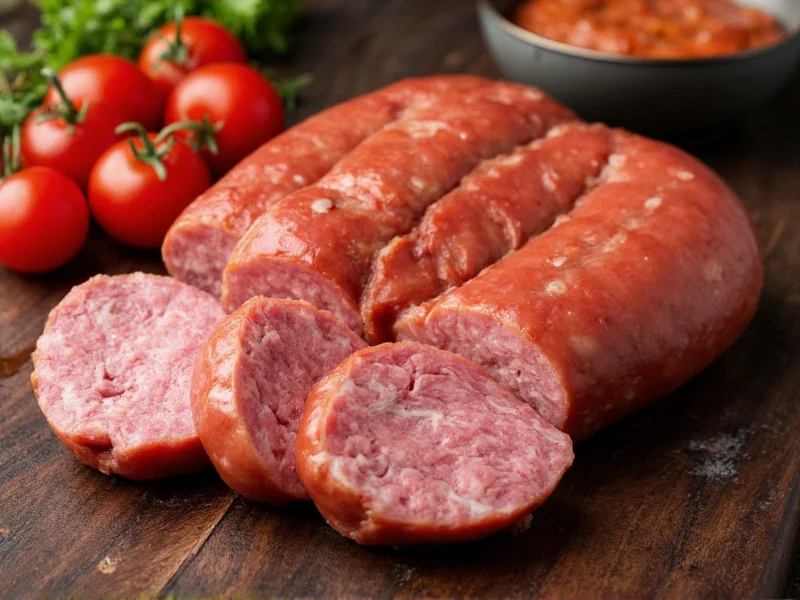Understanding whether sausage qualifies as red meat requires examining both its ingredients and processing methods. While the classification might seem straightforward, several nuances affect how different sausage varieties are categorized in nutritional science and dietary guidelines.
What Defines Red Meat?
Red meat refers to meat from mammalian muscle tissue, characterized by high myoglobin content that gives it a red color before cooking. The primary red meats include:
- Beef (including veal, hamburger, and steak)
- Pork (including bacon and ham)
- Lamb and mutton
- Game meats like venison
The color distinction between red and white meat isn't about cooked appearance but rather the oxygen-carrying protein myoglobin in the raw meat. Poultry and fish contain less myoglobin, classifying them as white meat.
Sausage: Processed Meat with Red Meat Characteristics
Most conventional sausages fall into the processed red meat category for two key reasons:
- Base Ingredients: Traditional sausages primarily use pork, beef, or a combination of red meats as their main protein source
- Processing Methods: Sausages undergo preservation techniques like curing, smoking, or adding sodium nitrites—hallmarks of processed meats
The World Health Organization's International Agency for Research on Cancer (IARC) specifically includes sausages in its definition of processed meat, stating: "Processed meat refers to meat that has been transformed through salting, curing, fermentation, smoking, or other processes to enhance flavor or improve preservation. Most processed meats contain pork or beef, but processed meats may also contain other red meats, poultry, offal, or meat by-products such as blood."
Exceptions to the Rule: When Sausage Isn't Red Meat
Not all sausages qualify as red meat. Several varieties fall outside this classification:
| Sausage Type | Meat Source | Classification | Nutritional Notes |
|---|---|---|---|
| Traditional pork/beef sausage | Mammalian (pig/cow) | Processed red meat | Higher saturated fat, contains heme iron |
| Chicken sausage | Poultry | Processed white meat | Generally lower in saturated fat than red meat varieties |
| Turkey sausage | Poultry | Processed white meat | Often marketed as leaner alternative |
| Veggie/vegetarian sausage | Plant-based | Not meat | No heme iron, variable protein content |
When evaluating is chicken sausage red meat, the answer is no—it's processed poultry. Similarly, turkey sausage falls under processed white meat. The critical factor is the animal source, not the sausage form itself.
Health Implications of Processed Red Meats Like Sausage
The classification matters because major health organizations differentiate between unprocessed red meat and processed red meat when making dietary recommendations:
- The WHO classifies processed meat (including most sausages) as Group 1 carcinogen, meaning there's sufficient evidence it causes colorectal cancer
- Each 50g daily portion of processed meat increases colorectal cancer risk by approximately 18% according to IARC analysis
- Processed meats often contain higher sodium levels (typically 500-700mg per serving) compared to unprocessed counterparts
- The heme iron in red meat may promote carcinogenic compounds in the gut
When considering is sausage bad for you, the answer depends on frequency and portion size. Occasional consumption fits within balanced diets, but regular intake of processed red meats like traditional sausages correlates with higher risks of:
- Colorectal cancer
- Type 2 diabetes
- Cardiovascular disease
Nutritional Profile of Common Sausages
Understanding sausage nutrition facts helps contextualize its classification. A typical 85g (3oz) serving of cooked pork sausage contains:
- 290-350 calories
- 25-30g total fat (including 9-12g saturated fat)
- 400-700mg sodium
- 12-15g protein
- Negligible carbohydrates
Compare this to the same portion of unprocessed pork chop:
- 200-250 calories
- 12-18g total fat (4-6g saturated fat)
- 50-70mg sodium
- 22-25g protein
The significant differences in sodium and processing methods explain why health organizations treat sausages differently than fresh cuts of the same meat.
Expert Recommendations on Sausage Consumption
Nutrition authorities provide specific guidance regarding processed red meats like sausage:
- The American Cancer Society recommends limiting processed meats including sausages
- Dietary Guidelines for Americans suggests choosing lean, unprocessed meats over processed varieties
- The World Cancer Research Fund advises avoiding processed meats entirely for cancer prevention
- Many cardiologists recommend treating sausage as an occasional indulgence rather than regular protein source
When evaluating processed meat health risks, experts emphasize that occasional consumption differs significantly from regular intake. The key is understanding portion sizes and frequency within an overall balanced diet.
Reading Labels to Identify Meat Classification
When determining is pork sausage red meat (it is), check product labels for these indicators:
- Primary ingredients: First ingredients should reveal the meat source (pork, beef, chicken, etc.)
- Processing indicators: Look for terms like "cured," "smoked," "preserved with," or listing sodium nitrite
- Nutrition facts: High sodium content (over 400mg per serving) suggests processing
- Health claims: "Lean" or "reduced fat" doesn't change the fundamental classification
Many consumers wonder about the difference between red meat and processed meat. While all processed sausages made from mammalian meat are both red meat AND processed meat, not all red meat is processed. A fresh pork chop is red meat but not processed, while pork sausage is both.
Practical Guidance for Consumers
Based on current nutritional science, here's how to approach sausage consumption:
- Consider traditional sausages as processed red meat for dietary planning purposes
- Limited consumption (1-2 servings weekly maximum) aligns with most expert recommendations
- Choose poultry-based sausages when seeking lower saturated fat options
- Always check sodium content, as some "reduced fat" varieties compensate with higher salt
- Balance sausage meals with abundant vegetables and whole grains
Understanding whether is sausage red meat matters because this classification directly impacts dietary recommendations from health authorities. While not all sausages qualify as red meat (poultry varieties don't), the vast majority of traditional sausage products fall squarely within the processed red meat category that nutrition experts advise consuming sparingly.











 浙公网安备
33010002000092号
浙公网安备
33010002000092号 浙B2-20120091-4
浙B2-20120091-4